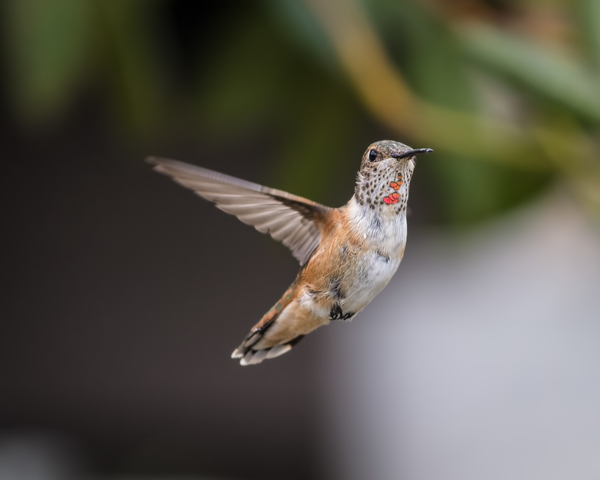
Hummingbirds are a captivating group of birds renowned for their extraordinary abilities and stunning beauty.
With over 300 species, these tiny avian wonders belong to the family Trochilidae and are primarily found in the Americas.
Their unique traits and behaviors have fascinated both scientists and bird enthusiasts for centuries.
In this detailed explanation, we will explore the fascinating world of hummingbirds, covering their physical attributes, incredible flight capabilities, feeding habits, mating rituals, distribution, and conservation status.
Hummingbirds are small birds, typically measuring between 3 to 5 inches in length and weighing only a few grams.
Their diminutive size is accentuated by vibrant, iridescent plumage, which reflects light and creates dazzling flashes of color as they move.
Many species exhibit distinct sexual dimorphism, with males displaying more vibrant hues to attract females.
One of the most remarkable features of hummingbirds is their wings.
Their wings can flap incredibly fast, ranging from 50 to 80 times per second, allowing them to hover in mid-air with remarkable stability.
This unique hovering ability is facilitated by their shoulder and wing structure, which enables them to move their wings in a figure-eight pattern.
Hummingbirds are unmatched when it comes to flight capabilities.
They can fly in all directions, including backward and upside-down, a feat few other birds can achieve.
Their agility and precision in flight enable them to navigate through dense vegetation and access nectar from deep within flowers.
To sustain their high-energy lifestyle, hummingbirds need to consume large amounts of food, often several times their body weight in nectar and insects daily.
The primary diet of hummingbirds consists of nectar from a wide variety of flowers.
Their long, slender bills and specialized tongues allow them to probe deep into flowers to access nectar reserves.
As they feed on nectar, they inadvertently pollinate flowers, making hummingbirds vital pollinators for numerous plant species.
In addition to nectar, hummingbirds also supplement their diet with insects and spiders.
This protein-rich food source is particularly important during the breeding season when they need extra energy for courtship displays and raising their young.
Hummingbirds are a true marvel of the avian world.
Their petite size, vibrant colors, and unparalleled flight abilities make them a delightful sight for birdwatchers and nature enthusiasts alike.
As we strive to protect and preserve their habitats, we ensure that future generations can continue to enjoy the mesmerizing beauty and fascinating behaviors of these “flying jewels” of nature.
Check out our collection of articles on Hummingbirds which will help you take good care of them and gain knowledge on Hummingbirds.
- When to Put Out Hummingbird Feeders?
- Where to Hang Hummingbird Feeder?
- Why Won’t Hummingbirds Come to My Feeder?
- How to Attract Hummingbirds to Feeder?
- 10 Best Plants and Flowers That Attract Hummingbirds
- Types of Hummingbirds in Florida
- When to Stop Feeding Hummingbirds?
- What Time of Day Do Hummingbirds Feed?
- Where Do Hummingbirds Go At Night? Where Do Hummingbirds Sleep?
- Types of Hummingbirds in Ohio
- Best Hummingbird Food Recipe without Boiling
- How to Keep Bees Away From Hummingbird Feeders?
- Hummingbird Identification with Chart
- How to Keep Ants Out Of Hummingbird Feeders?
- What Do Hummingbirds Eat?
- Types of Hummingbirds in California
- Types of Hummingbirds in Colorado
- Types of Hummingbirds in Maine
- Types of Hummingbirds in British Columbia (BC)
- Types of Hummingbirds in Texas
- Male vs Female Hummingbirds
- Types of Hummingbirds in Illinois
- Types of Hummingbirds in New Jersey
- Types of Hummingbirds in Virginia
- Types of Hummingbirds in New York
- Types of Hummingbirds in Indiana
- Types of Hummingbirds in Kentucky
- Types of Red Hummingbirds in North America
- Types of Hummingbirds in Pennsylvania
- Types of Blue Hummingbirds in North America
- Types of Hummingbirds in Ontario
- Types of Hummingbirds in Minnesota
- Types of Hummingbirds in South Carolina
- Best Types of Red Flowers for Hummingbirds
- Types of Hummingbirds in Georgia
- Types of Hummingbirds in Michigan
- Types of Hummingbirds in Tennessee
- Types of Hummingbirds in Kansas
- Types of Hummingbirds in Connecticut
- Best Annuals that Attract Hummingbirds
